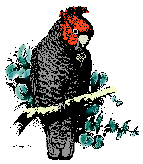Many thanks Steve, adult and juvenile/fledgling Koels appearing to associate is something I will briefly raise at the end of my presentation tomorrow evening, so you might like to raise it further in question
time.
Interesting too, is that last Wednesday (5/2) there were 2 very noisy Koel fledglings being fed outside the café. A couple of weeks earlier there were also two, one around the Banksia Centre and the other
around 200 m further up the hill towards the Sydney area. I couldn’t find another on a walk through and while I have no proof it is possible that these two came together and moved another couple of hundred metres. Helen Cross photographed the 2 together
and posted them on Canberra Nature Map on 28/1.
Jack Holland
From: Canberrabirds
<> On Behalf Of Steve Read via Canberrabirds
Sent: Tuesday, 11 February 2025 2:16 PM
To: 'Canberra birds' <>
Subject: [Canberrabirds] Koels associating
Hi all
The soundscape for birders who gathered at the ANBG cafe this morning for the monthly Canberra Birds get-together was dominated by koels. As well as various koels calling in the background
(along with the sounds of magpies, currawongs and wattlebirds), a fledgling koel was begging incessantly in the small tree at the edge of the cafe verandah. It was attended and fed regularly by a wattlebird - and a female koel also flew down and spent time
in the same tree.
The presence of the female koel close to the fledgling reminded me of a discussion at the Canberra Field Naturalists meeting last week. Several participants there commented on the higher level
of koel activity in their suburbs in recent weeks – birds calling in the daytime, fledglings begging and, specifically, adults being present and active near those fledglings. I commented that there were as yet no good data supporting a direct association between
adult koels and their offspring, but it does appear that these behaviours are increasingly being observed.
I can think of three possible reasons why adult koels might associate with – or appear to associate with - fledgling koels:
- common resource: such as both being attracted to fruiting trees. This is clearly possible, but does not explain adult koels being present
near fledgling koels that are still being fed by their hosts.
- intraspecies flocking: many bird species form flocks after breeding, and after the breakdown of breeding territory boundaries. One can
speculate on a number of adaptive reasons for this, including younger birds learning from the behaviour and calls of older birds, even if they subsequently migrate separately.
- parental support: this would be the case if the adult female koels associating with younger koels are actually the egg-laying parents
of those younger koels, and are seeking to bond with or protect them in some way.
Philip Veerman has previously given cogent reasons why none of the above may be necessary or likely, and he may of course be correct. However, observations of such adult koel-young koel associations
do appear to be increasing, and may be worthy of our attention: if we do not investigate the unlikely, we will never discover the unexpected.
Regards to all
Steve

